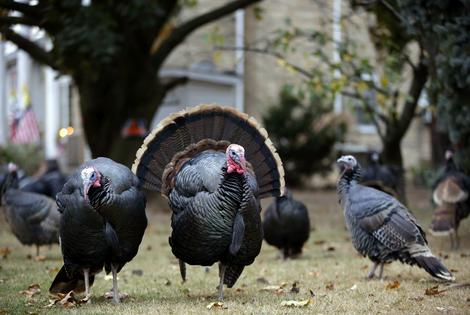Wild turkey numbers are falling in some parts of the US – the main reason may be habitat loss
Published in Science & Technology News
Birdsong is a welcome sign of spring, but robins and cardinals aren’t the only birds showing off for breeding season. In many parts of North America, you’re likely to encounter male wild turkeys, puffed up like beach balls and with their tails fanned out, aggressively strutting through woods and parks or stopping traffic on your street.
Wild turkeys were abundant across North America when European settlers arrived. But people killed them indiscriminately year-round – sometimes for their meat and feathers, but settlers also took turkey eggs from nests and poisoned adult turkeys to keep them from damaging crops. Thanks to this unregulated killing and habitat loss, by 1900 wild turkeys had disappeared from much of their historical range.
Turkey populations gradually recovered over the 20th century, aided by regulation, conservation funding and state restoration programs. By the early 2000s, they could be found in Mexico, Canada and every U.S. state except Alaska.
Now, however, the trend appears to be reversing in some areas. In a 2021 study, eight out of 30 states surveyed reported that turkey populations declined from 2014 to 2019, with some of the sharpest decreases in Alabama, Arkansas, Georgia, Louisiana and Oklahoma.
Turkey numbers increased in 14 states, mainly in the Northeast and mid-Atlantic. But even in many of those states, populations were down from historic peaks in the early 2000s. Another study in 2023 reported that turkey populations in the eastern half of the U.S. were declining by about 9% yearly, based on data from the past 50 years.
We are wildlife ecologists working to determine why turkey populations are shrinking in portions of their range. This is a classic challenge in ecology: Many factors could be at play, and it takes careful analysis to untangle them and figure out whether each trend is a cause or symptom – or just irrelevant.
We created the Wild Turkey Science podcast to make peer-reviewed science accessible to the public and provide a platform for turkey researchers and biologists to discuss their work. So far, we have reviewed numerous studies and interviewed scientists from more than a dozen states. Here are some hypotheses that have emerged:
While turkeys may appear at home in urban areas, their habitat is open forest – areas with sparse trees that allow near-full sunlight to reach herbaceous plants at ground level. Most uplands, or elevated areas, in the eastern U.S. historically were this type of dry-adapted woodland, savanna and grassland complex.
In 1792, naturalist William Bartram described the eastern U.S. as “Grande Savane,” or big savanna, a landscape with abundant wild turkeys. Traveling in Florida, Bartram wrote:
“I was awakened, in the morning early, by the cheering converse of the wild turkey cocks saluting each other from the sun-brightened tops of the lofty cypress and magnolia. They begin at early dawn, and continue till sunrise. The high forests ring with the noise of these social sentinels, the watchword being caught and repeated, from one to another, for hundreds of miles around, insomuch that the whole country is, for an hour or more, in an universal shout.”
Today, very little woodland or savanna remains in the U.S. Most of it has been cleared for development, farming or livestock grazing. The open spaces that are left often are not suitable for wild turkeys: They need a well-developed layer of vegetation at ground level that includes mainly wild flowers, native grasses and young shrubs and trees to provide cover for nesting and raising their young.
Very few of the remaining lands suitable for wild turkeys are managed using frequent, low-intensity prescribed fire, which creates and maintains a mosaic of open forest and grassland by continually setting back growth of trees, shrubs and vines. Suppressing fire in these forests across the eastern U.S. allows them to change from open forest dominated by fire-adapted grasses and wildflowers to closed forests with dense canopies, creating shady, moist conditions with minimal vegetation near ground level.
Turkeys can persist in these denser, shaded forests, but they don’t reproduce as successfully, and fewer of their young survive. The lack of ground vegetation makes it hard for hens to hide their nests, and it limits food supplies for young turkey poults.
This isn’t just a problem for wild turkeys. Over the past 50 years, populations of bird species that live in open forests and grasslands have fallen by more than 50%. Grasslands and savannas support hundreds of other wild species as well, many of which are declining.
Scientists have proposed other explanations for turkey declines, but many of these hypotheses are at least partly habitat issues.
For example, blame is often placed on more abundant predators that eat turkey eggs, such as raccoons and opossums. But these predators probably are more abundant in part due to changes in turkey habitat.
For example, a 2024 study found that a range of mammals that eat turkey eggs were observed 70% of the time when prescribed burning was not used, but were observed less than 10% of the time in open forests where planned burns were conducted biannually. This suggests that prescribed fire across the wild turkey’s range creates an environment that’s more favorable for turkeys than for their predators.
Some observers have suggested that turkeys may be so abundant that the landscape can’t support their current population, so now they are declining to a more sustainable level. If turkey habitat remained stable, we would expect to see their numbers go up and down naturally, but their average abundance over time would remain the same. Instead, turkey numbers appear to be slowly but steadily falling in many areas – perhaps signaling that habitat availability is declining along with turkey populations.
What about food supplies? Young turkeys feed on insects, so insect declines may explain some observed changes in turkey populations. According to one calculation, land-dwelling bird species that depend on insects as food have declined by 2.9 billion individuals over the past 50 years, while those species that don’t have gained by 26.2 million individuals.
Insect losses could explain why fewer turkeys are surviving to adulthood, but insects depend on plants, so this shift is likely also linked to habitat changes. And where land is managed to promote native flowers and grasses, there also are abundant pollinators, ants, grasshoppers and spiders that turkeys relish.
Lastly, some observers have proposed that the timing of hunting could be affecting turkey reproduction. However, a recent study in Tennessee found that this was not the case. Another recent study showed that hunters in the Southeast were harvesting about the same share of male turkeys as when turkey populations were growing rapidly. If current turkey harvest rates are unsustainable, the explanation is likely that wild turkey productivity has declined for other reasons, such as habitat.
Land owners can help by managing for native grasses and wildflowers on their property, which will provide breeding habitat for turkeys. We have produced podcast episodes that discuss which plants are valuable to turkeys and other wildlife, and how to promote and maintain plants that are turkey-friendly.
People who don’t own land can support state and local efforts to restore wildlife, contribute to local wildlife conservation groups and buy hunting licenses, which help to fund wildlife management programs. With the right conditions, this iconic North American species could thrive yet again.
This article is republished from The Conversation, a nonprofit, independent news organization bringing you facts and analysis to help you make sense of our complex world.
Read more:
Animals large and small once covered North America’s prairies – and in some places, they could again
It’s OK to feed wild birds – here are some tips for doing it the right way
Marcus Lashley receives funding from the Florida Fish and Wildlife Commission, the National Wild Turkey Federation, and Turkeys for Tomorrow.
William Gulsby receives funding from the Alabama Wildlife Federation, Turkeys for Tomorrow and the National Wild Turkey Federation.








Comments